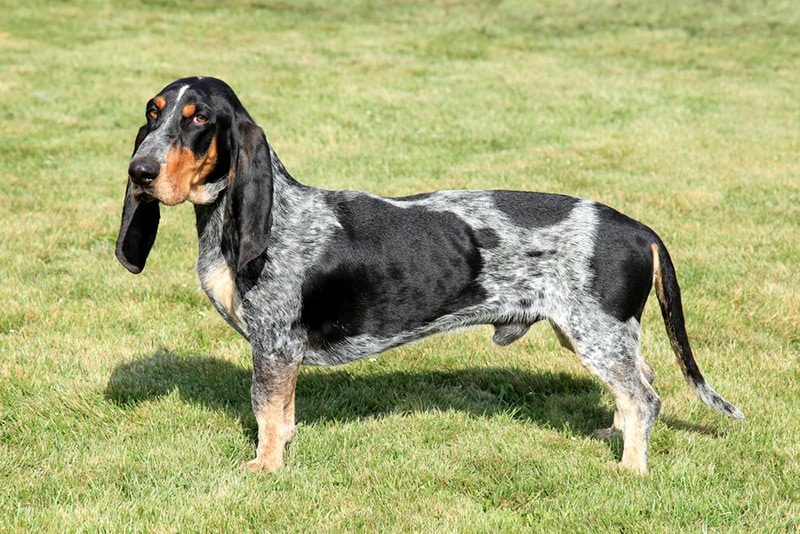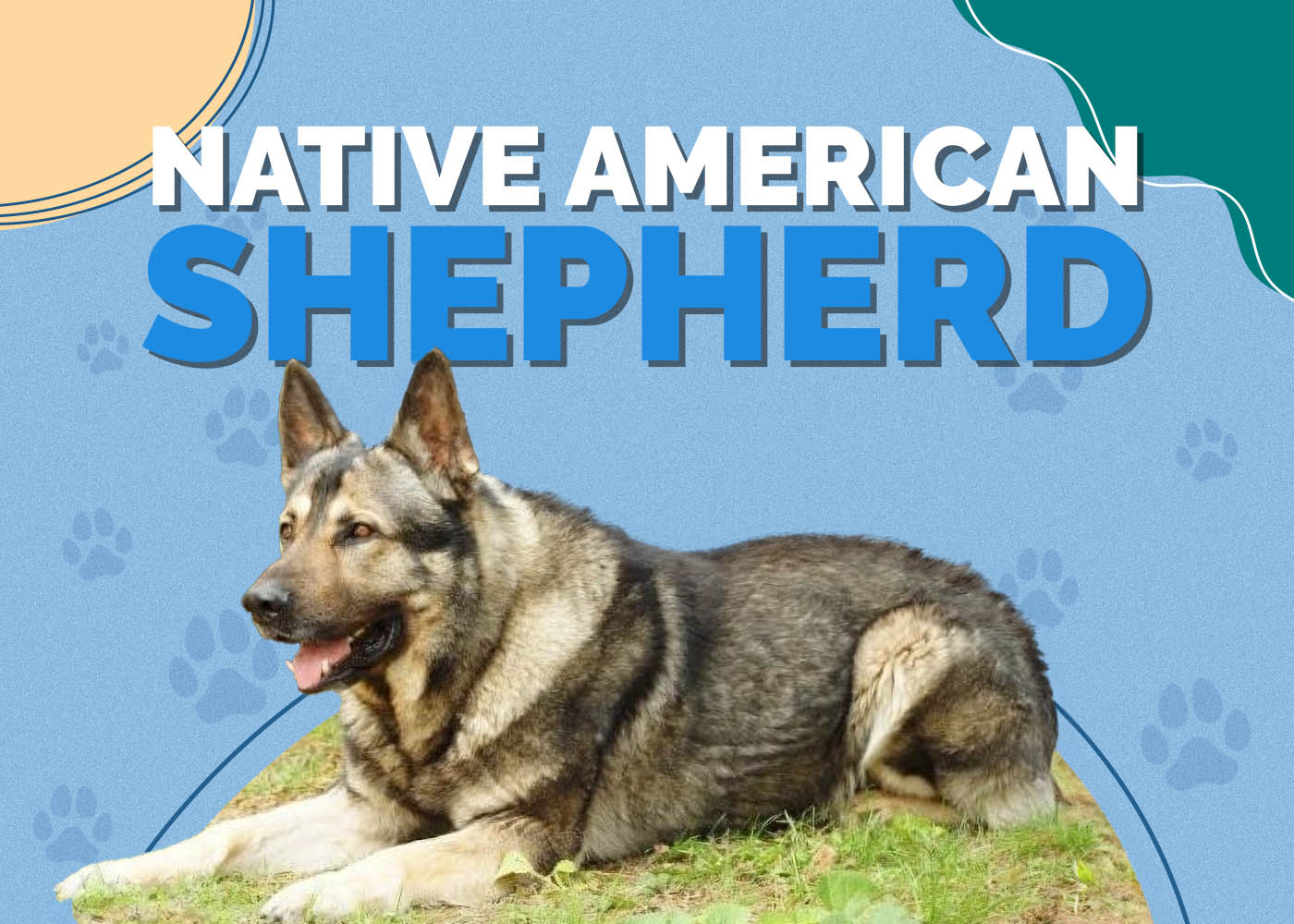Blue Gascony Basset: Pictures, Care Guide, Temperament & Traits

Updated on

The Blue Gascogny Bassett, which is also known as the Basset Bleu de Gascogne, is a Basset-type hound from the Gascogny region of Southwest France. Although it has a similar shape and features to the Basset, the short legs and long ears aren’t as pronounced. The breed has a very strong scent sense, having been bred to hunt game including boar and deer. It has a lot of stamina and will work or walk all day before happily spending its time at home with either human or canine companions.
Although the breed can make a very good companion pet, potential owners need to be aware of the Basset’s propensity to vocalize with howls and noises. These sounds can travel, and they may be enough to prevent the Blue Gascony Basset from making a good apartment neighbor.
| Height: | 13–15 inches |
| Weight: | 35–45 pounds |
| Lifespan: | 10–14 years |
| Colors: | Black, white, blue, brown, tan |
| Suitable for: | Active families, especially those that want to partake in scent sports |
| Temperament: | Friendly, fun, loving, eager to please, pack animal |
The Blue Gascony Basset is not officially recognized by the American Kennel Club but was recognized by the United Kennel Club in 1991. It is also recognized by the Kennel Club of the United Kingdom and by the Federation Cynologique Internationale.
Blue Gascony Basset Characteristics
Blue Gascony Basset Puppies
The Blue Gascony Basset is one of the rarer Basset hounds, and there are few breeders outside their home country, France. This means that it can be very difficult to find breeders. If you do find a breeder, they are likely to have a waiting list, and you will need to register to be informed of when a puppy will become available. The breed nearly died out in the 20th Century and while it was rescued by breeder Alain Bourbon, there were still only believed to be around 200 Blue Gascogny Basset puppies born in 1980. The best way to find a breeder is to locate breed groups, talk to members, and see if they know of any Basset breeders that might have this specific breed.
The puppies themselves are usually well-behaved but these are pack animals and they do require the company of other canines or humans. They need early socialization and training, and they will want to exercise their incredible sense of smell from a young age.
Temperament & Intelligence of the Blue Gascony Basset
The Blue Gascony Basset is an intelligent dog that was bred for hunting. It is a scent hound, which means that it puts its trust in its sense of smell. When the breed latches onto a scent that it wants to follow, it can be very challenging to drag its attention away. While this makes it useful for scent sports, it can also bring training sessions to a standstill if the dog does sense something it wants to follow.
It is a pack animal, which means that it doesn’t always do well when left alone for long periods, and its tendency to howl means that the Blue Gascony Basset is not deemed suitable for life in an apartment, in most instances.
Are These Dogs Good for Families? 👪
The Basset Bleu de Gascogne is a pack animal. It would typically be kept as one of several Bassets and would live with the other dogs, providing company and companionship. As a companion pet, the Gascony requires a similar level of pack companionship, although this can be provided by other dogs or by people. The dog gets along well with family members and can make a very loving pet.
It does well with children, and it will especially enjoy the company of family members that are old enough and willing enough to accompany it on scent-trailing walks.

Does This Breed Get Along with Other Pets?
Although Bassets are hunting dogs, the Basset Bleu de Gascogne is used for hunting larger animals like boars and deer. As such, this slow-moving and generally placid dog won’t chase cats and can usually live well with cats. The Basset will benefit from living in a house with other dogs, especially if its humans go out to work or are out of the house for long periods.
Things to Know When Owning a Blue Gascony Basset:
The Blue Gascony Basset is a working dog, and it has working dog traits. This means it requires plenty of exercise, although the breed does not require anything too strenuous. It can be trained, although the urge to follow a scent may make training in a park or anywhere with interest smells a bit of a challenge.
As long as you are willing to meet these exercise requirements, and put up with the potential for howling, the Blue Gascony can make an excellent family companion.
Food & Diet Requirements 🦴
Typically, you will need to feed between 1.5 and 2.5 cups of dry food per day to meet a Gascony’s. Alternatively, you can feed wet or canned food, following the manufacturer’s guidelines according to the weight and age of your dog. You can also feed a combination of dry and wet food, but you need to ensure that you don’t overfeed the dog or it can put on excess weight, which can harm your dog’s health.
Exercise 🐕
Although the breed is not fast and won’t usually need to run or charge around, it does have plenty of stamina and the Gascony Blue needs approximately 2 hours of walks a day. Ideally, this should be broken down into two or even three roughly even walks. Regular exercise will help keep your Basset healthy and ensure that it doesn’t put on too much weight.

Training 🎾
The breed is a working dog. Specifically, it was bred as a hunting dog, and it still has hunting instincts. This means that it will generally follow any scent it finds interesting and has an incredibly keen sense of smell. This can make training difficult because if your Basset picks up a smell during training, it will lose interest in what you’re doing. Start training when the dog is young, work on recall, and continue with training as the dog reaches maturity and into its adult life.
You can also enlist in scent sports. This will satiate your dog’s desire to follow scents and provide enrichment while building a bond between the two of you.
Grooming ✂️
The breed doesn’t have particularly high grooming requirements. Weekly brushing, with daily brushing during the shedding season, will help reduce the number of stray and floating hairs that you have to contend with. During your weekly brush, use the opportunity to check inside your Basset’s ears. The breed is prone to ear infections, so look and clear out any buildup of wax.
Health & Conditions 🏥
Although the breed is generally fit and healthy, there are a few problems to keep an eye out for. Bassets are prone to obesity, especially if they don’t get enough exercise, and ear infections are common because of the size and shape of the ears. Intervertebral disc degeneration can be a problem because of the long back and short legs of the breed. Other possible conditions include eye problems and patellar luxation.
- Ear Infections
- Eye Problems
- Patellar Luxation
- Intervertebral Disc Degeneration
- Glaucoma
Male vs Female
There are not any significant differences between male and female Blue Gascony Bassets, although the male may grow a little taller and heavier than the female.
3 Little-Known Facts About the Blue Gascony Basset
1. They Are Ideally Designed to Pick Up Scents
Everything about the Blue Gascony Basset is designed to help it detect and follow scents. Its low body means that the dog’s nose is always close to the ground, while the long ears help to push scent up towards the nose and make scents easier to detect.
2. They Like to Have Their Voices Heard
One of the potential pitfalls of owning this breed is that it can be quite loud and very much enjoys having its voice heard. Rather than barking, Bassets are inclined to howl, and they do so as a means of communication, not just when they are startled or alerted. This tendency means that the Blue Gascony Basset is not ideally suited to life in an apartment because neighbors will be able to hear the Basset.

3. They Are Surprisingly Heavy
Despite having short legs and looking like small dogs, they are deceptively heavy, weighing up to 70 pounds. In fact, Bassets are known to have the highest bone density per pound of dog, so don’t be expecting a light weight when it jumps up to curl on your lap.
Final Thoughts
The Blue Gascony Basset is not an officially recognized breed, at least by the AKC, but it is one of several Basset breeds and one of many French hound breeds. It does require plenty of walks, each day, and the breed benefits from being given scent work to keep it busy and fulfilled.
It also makes a great companion dog that will get along well with family members, other pets, and visitors, but the howling of the breed may mean that it isn’t suitable for life in an apartment or in any residence where neighbors are very close by.
Featured Image Credit: Radomir Rezny, Shutterstock











